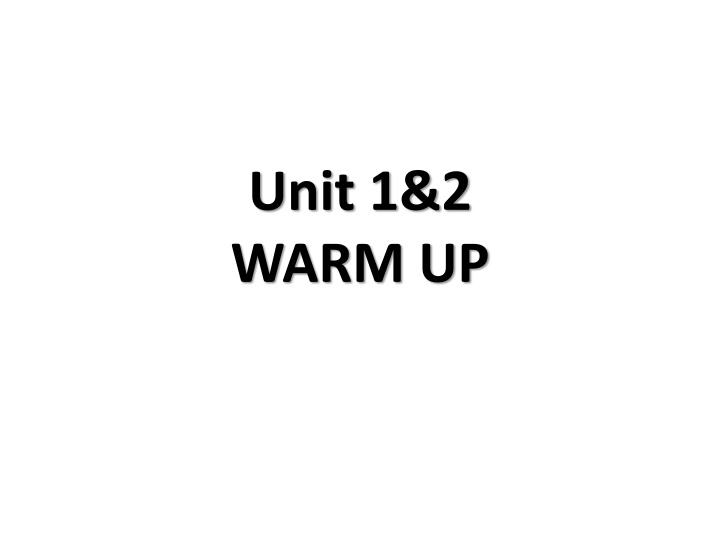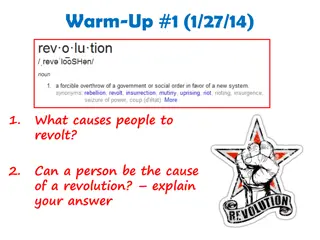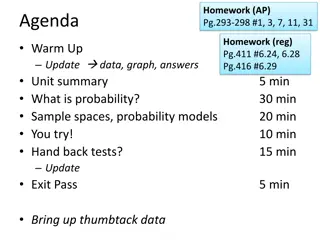Unit 1&2 Warm Up Activities
"Engage in a variety of warm-up exercises from units 1 and 2 to kickstart your learning journey. These activities are designed to get you ready for the lessons ahead and help you retain information better."
Download Presentation

Please find below an Image/Link to download the presentation.
The content on the website is provided AS IS for your information and personal use only. It may not be sold, licensed, or shared on other websites without obtaining consent from the author.If you encounter any issues during the download, it is possible that the publisher has removed the file from their server.
You are allowed to download the files provided on this website for personal or commercial use, subject to the condition that they are used lawfully. All files are the property of their respective owners.
The content on the website is provided AS IS for your information and personal use only. It may not be sold, licensed, or shared on other websites without obtaining consent from the author.
E N D
Presentation Transcript
Unit 1&2 WARM UP
Questions....... What is meant by? (2 marks) Explain two methods/ ways (4-6 marks) How could? Recommend? (9 marks) Use the case study, when you state something back it up with a suggestion for the business. 9 marks Assess advantages and disadvantages, evaluation
Reasons for setting up a business, read the case: Own boss, keep profits, escape employment, pursue an idea, social enterprise Franchise; Using an existing franchisor name and products Adv - existing reputation, brand name, training support, national marketing support Dis- balance of power between franchisor and franchisee, give some profits away Unit 1.1 Starting a business Aims and objective: Survival Make a profit Customer satisfaction Be ethical Market share Social enterprise- a business set up to help society not just for profit Sole Trader ADV Quick, handle all decisions, keep all profit DIS Unlimited liability, stressful workload, may find finance difficult Stakeholders employees, suppliers, customers , community, managers Gap in the Market (Niche) Benefits less competition, growing market, potential high sales Private Ltd ADV Limited liability, sell shares, higher reputation DIS Legal procedures, final accounts need to be produced Partnership (2-20)- ADV More finance, ideas, specialise in different areas DIS disagreements, share profits, still UNLIMITED Business plan reduce risk, lack of experience, need capital DIS Cant guarantee success owners maybe unsure how to write one Location Maximise revenue, minimise costs Availability, competitors , employees, costs, sales potential DEPENDS ON THE TYPE OF BUSINESS
Market research enables a firm to find out about its market, customers and competitors Secondary ADV Less time to carry it out Sometimes larger scale information gathered Unit 1.2 Marketing Marketing Mix the four major variables of marketing - Price Place Product Promotion PRICE What must a business consider when setting a price COST COMPETITION LOCATION IMAGE Low price is not always the answer Primary research is gathering new information e.g Questionnaire Product What products a SMALL business is likely to offer sometimes unique to Large businesses to compete Secondary research is using existing research Primary ADV Tailor research questions specifically Cheap Can speak to consumers face to face e.g focus group/ customer or supplier feedback Promotion Place Method of distribution How goods are transferred from manufacturer to customer Limited budget promotions such as Local newspaper advertising, PR, Direct mail, Personal selling, Website Place Producer Retailer Customer Producer wholesaler retailer customer
Sources of finance What do they need finance for? Bank Loan ADV Advice/ instalments DIS - Interest Family and Friends ADV Flexible payments DIS Conflict Overdraft ADV Can regularly use it DIS High charges/interest Mortgage ADV instalments/ spread cost DIS - interest Trade credit ADV Finance period DIS Extra debt Government Grant ADV Free DIS Need qualifications for grant Calculations Revenue = Selling price x units sold Costs = Variable costs + Fixed costs Profit = Sales revenue - costs Cash Flow A prediction of a business inflows and outflows, showing the closing balance Unit 1.3 Finance Why have a cash flow: Organise costs See potential areas to improve Help persuade a bank for investment Foresee overdraft Ways to improve cash flow Spread payments Encourage receipts to be paid Cut payments
Demand for labour Nature of the job Job Selection Appointment Induction advertisement What will be their duties and responsibilities? JOB DESCRIPTION* PERSON SPECIFICATION* The business must decide whether to recruitment internally (from within) or externally (outside) How many? Full- or part-time What hours? When to start Newspapers Professional magazines Internet Job centre Word of mouth Induction programmes are used to ensure staff are happy and prepared for employment Care must be taken to ensure selection is mindful of laws relating to employment (discrimination) An EMPLOYMENT CONTRACT must be provided that states 1. Job title 2. Location 3. Hours of work 4. Salary/wage 5. Holidays and other entitlements 6. Terms of notice Application form CV References presentations Aptitude tests (role play) Interview panels Psychometric tests Rules of the business Location of different departments how the business operates Businesses will think about the cost of advertising Unit 1.4 People in Business Monetary Motivation: Wage/ salary/ Bonus Non Monetary motivation: Responsibility/ promotion/ fringe benefits Protecting staff Minimum wage Equal Pay Health and safety Small business cannot ignore and can be costly Motivated staff output/profit increase/ reputation/ less staff leave
Operationally efficient Keeping costs low but maintaining a good standard Unit 1.5 operations Consumer protection; Job production: making one off specialised product for each customer ADV- meet customer requirements/ charge high price DIS slow to make/ labour coats/ material cost high Good should be fit for purpose. Ways to be more operationally efficient? Customers protected by law Efficient machinery Motivated staff Minimum waste Effective management Customer service Before During After Batch production: groups of identical items that pass through different stages of the production process ADV Lower unit costs/ make more of the same item DIS lose some specialisation ADV Can charge lower process Quality Assurance checking products/ services ICT Ecommerce ADV and DIS to customers Changes in technology; ADV Lower unit costs/ Better communications/ Quicker/ Flexible DIS Cost/ training/ demotivation/ breakages ADV and DIS to business
Reasons for Growth: To increase sales To increase market share Take advantages of economies of scale Reputation increases 2.1 The Business organisation Inorganic Growth: Horizontal integration (TAKEOVER) Methods for expansion Organic growth: expansion within the business Inorganic growth: expansion by merging or taking another business. Disadvantages: Conflicts between stakeholders: E.G Customers might not be happy Employees might lose their jobs Shareholders have to sell shares, lose control Reasons against growth: Lose control May lose a personal service with customers Risk Increased workload Organic growth: Open more branches/ launch a new product Selling on the internet (ecommerce) Sell Franchises Public Limited Company PLC Sell shares to the public on Stock exchange Higher status/ reputation Pay dividends to shareholders Potential to raise large capital Accounts have to be made public Private Limited Company (ltd) Features: More status than a sole trader Limited liability Original owners become directors Raise share capital from private investors
Changing aims and objectives Profit growth Increase market share Increase shareholder value Ethical objectives 2.1 The Business organisation Location: Aims Maximise revenue, minimise costs Things to consider: Cost of site Labour costs Transport costs Sales potential Managers preference International Location Drawbacks : Language difficulties Transport costs of goods Bad publicity lose national pride Unethical paying lower wages UK employees lose jobs Social Cost and benefits Ethical objectives: Environmentally friendly Treating workers fairly Treating suppliers fairly (Fair trade) Benefits of being ethical Improve reputation amongst customers, suppliers and workers International Location Benefits of locating abroad: Low costs labour and materials Avoid trade barriers Take advantage of a different market
Pricing decisions are based on Competition The market Cost of production Market Research in Unit 2 is limited. As a growing business they receive market research through Competitors, consumer feedback, contact with producers/suppliers 2.2 Marketing 4 P s (Marketing Mix) http://www.nibusinessinfo.co.uk/sites/default/files/product_lifecycle_0.jpg Competitive pricing setting a price for a product based on prices Price skimming setting a high price at a high level to create a high quality image Product portfolio selling a range of products: Benefits: Customer spends more Different target market Diversify if product failing Launch sales slow Growth Sales demand accelerated Maturity Sales level off sue to competition, consumer already have the product Decline sales fall Price penetration setting a low price at a low level to gain market share and gradually rising with reputation Drawbacks of large portfolio: Many managers have to be employed Publicity could be harmed by another product Development costs high Cost plus pricing setting a price by adding a profit mark up to the cost of production Extension strategies Update design Re Brand Target new markets Loss leader Pricing: setting a price below cost hoping to gain sales
Aims of promotion Inform customer Create brand image Support Price reduction, discount Help sales growth 2.2 Marketing 4 P s (Marketing Mix) Promotional considerations: Cost Nature of the product Nature of the marketing Place Producer Retailer Customer Producer wholesaler retailer customer Advertising Communication through media TV, newspaper CUSTOMER ONLY Telesales Selling to the customer through telephone contact Internet selling Selling straight to the customer via the internet Mail order Direct marketing through mail (catalogues) Sales Promotions Direct Marketing Email, telemarketing, direct mail TRADE and CUSTOMERS 2-4-1 10% off etc Sponsorship Sponsor an event to raise profile, can be product related but must meet target market
Large businesses need extra CAPITAL (money) to expand 2.3 Finance Advantages Disadvantages Retained Profit: Profit kept in the business No interest paid No loss of control Profits maybe to low to fund expansion Share capital does not to be repaid No interest New share issue: PLC and Ltd companies can sell shares Dividends will have to be paid Loan or mortgage: Borrowing money from the bank, mortgage for a property Interest could be high Must be repaid Property will have to be given up if can t pay the debt No loss of control Lower interest for larger companies Selling unwanted assets: Selling an asset such as a building to gain capital. Could leaseback (rent) No loss of control Finance raised but can still use the asset if leased The asset is no longer owned Rental/ leasing costs
Financial statements: Profit and loss account and Balance sheets 2.3 Finance Balance sheet Fixed Assets Current Assets Current liabilities 5m Long term liabilities 2m Nets assets ----------------------------------- Shares Retained Profit Total Capital 20m 10 m Stakeholders interested in accounts because: Shareholders whether to invest more, dividend return Banks see if loan can be paid back, safe to lend more Government Tax Employees Job Security Profit and Loss Sales Costs of sales Gross Profit Exp/overheads Net Profit 5m 2m 3m 2m 1m 23m 10m 13m 23m Sales the value of sales revenue. Selling price x units sold Cost of sales value of stock bought in to make the product/ service Gross profit Sales Cost of sales Overheads other fixed costs such as wages, elec Net profit Gross profit overheads IMPORTANT FIGURE Interpreting accounts Gross profit margin: GP/Sales x100 Net Profit margin: NP/ sales x 100 For every 1 of sales how much profit is there Fixed assets items owned over a year e.g. building, vehicles Current assets items owned under a year stock, debtors Current liabilities items owed under a year creditors Long term liabilities owed over a year mortgage or loan Current ratio: CA/CL Acid test Ratio CA-stock/CL Test liquidity. For ever 1 assets how much liability is there.
Two types Flat structure Less levels of management, more span of control Organisational structure: Makes clear who is responsible for which department How employees can communicate Allows layers of management Layers of management: Number of different managers in an organisation Tall structure more levels of management, less span of control Span of control: The number of employees each manager is responsible for. http://www.bbc.co.uk/schools/gcsebitesize/business/images/people2.gif 2.4 People in Business Flat advantages Quicker communication to the top as less levels of management More responsibility to the workers motivated by this Tall Flat Centralisation organisation Senior managers make all decisions Strong leadership needed Central decision should be consistent Allows for quick decisions Tall Advantages Fewer staff to control Senior managers make decisions less risk Training costs fewer Promotion opportunities
Decentralisation organisation Decision making spread across middle managers Local managers may have better knowledge Motivation giving responsibility for lower managers Advantages of Staff training Cope with changes Increase productivity Reduce chance of poor quality Staff motivated Disadvantages of Staff training Cost Workers trained and not working Employees move on with qualifications gained Recruitment Stage 1 Analyse the job Stage 2 Job description/ job specification Stage 3 Advertise Internally or externally Stage 4 Application Stage 5 Testing/Interview 2.4 People in Business Staff appraisal Done between managers and employees Provide feedback Set objectives Identify training needed Remuneration methods Method of paying employees to motivate them Piece rate (paid for individual output) Hourly wage rate Salary Profit sharing Motivating staff Training Management Remuneration methods Autocratic managers who believe in taking all decisions Democratic allowing employees to make decisions
Advantages of FP Economies of scale Computer/machinery accuracy Less stock need to be held Aims of operations: Efficiency Little wastage, low costs , helps to compete High Quality Maintain standards, justify price Production Methods Flow: Continuous production line Features: Large scale, usually one product, specialisation of labour, Division of labour Disadvantages of FP Set up costs Production problems causes whole line to stop Worker motivation Lean Production A production approach that aims to use a few resources as possible Division of labour: Breaking a job into smaller tasks repeated by a machine or worker Operations Kaizen Continuous improvement -Workers look at ways to improve the production process Just in Time manufacturing Features: Arranging with suppliers that materials/ stock arrive a day/week before producing Producing to order when customers make that order Advantages of JIT Cuts stock holding space Improves cash flow by reducing payments Good supplier relationships Cell production Working in teams for one product Lean Design Creating products visually before developing them Disadvantages of JIT Customers may have to wait Dependant on suppliers Small orders may increase costs
Main Economies of scale Bulk Buying larger orders with discounts Technical more efficient technology and computers Specialist managers afford to employ specialist a managers Financial benefit from lower interest rates on loans Benefits of growth Financial market share, revenue, profit Operations Lower unit costs (EOS) Main causes of poor quality Poorly motivated workers No responsibility from workers Lack of consistency Outsourcing other firms don t have the same standards Inspection costs- every worker must be meeting standards TQM Operations Total Quality Management Main Diseconomies of scale Poor communication Large businesses have layers of management difficult to pass through the whole business Poor Motivation Some workers feel uninvolved Poor coordination Complex decisions can take time Many outlets/ factories etc. hard to coordinate Involving all employees in the quality checking and taking responsibility Employees no longer think that quality is down to somebody else























